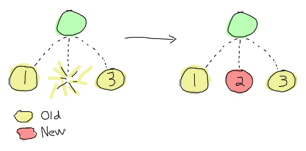programming distributed system elixir erlang
From Modern C++ to Modern Web Applications 4: Introduction to Elixir
Read the previous articles in the serie here: Part 1, Part 2, Part 3
Behold the sexiest language I've seen in years!

Erlang, the patriarch
I can't really talk about Elixir without mentioning Erlang first.
Erlang is a mature language developed by Ericsson in the eighties, and open-sourced in 1998. It powers many Ericsson routers, so you're probably using it when sending a dick pic to your girlfriend without even noticing...
Now it is used in production by many big names: Github, WhatsApp, Facebook, Grindr, etc.
Erl-whaaaa?
An executive summary of the language would look something like that:
- Functional language
- Dynamically typed
- "Prolog-y" syntax
- Runs on a VM
- Super lightweight because of its history in embedded systems
- Spawning thousands of concurrent processes is the norm (they're NOT OS processes)
- Processes communicate via message-passing
- Distributing your application on several nodes doesn't require much code change
- Recursion and pattern-matching make it easy to read code
- You can even hot-swap code (although it is not easy)
- Battlefield-tested for more than 20 years
- Only 30 engineers work at WhatsApp, and they're dealing with millions of users.
Some people despise its syntax. I don't really care, it's still easier to read than a Perl regex... Here is an example module containing the factorial function:
As you can see, recursion is highly recommended in Erlang. You don't have to worry about efficiency, the compiler optimizes it for you.
Coming from C++, you'll probably notice some kind of function polymorphism as well. The fac function has 2 different bodies: the first one returns 1 when the function parameter evaluates to 0, the second one returns N times fac(N-1). Note that there is no "return" keyword. The function returns the value of the last expression in its body.
The big difference with C++ is that you don't dispatch using the (static) function signature (e.g. arguments types and qualifiers), since there is no type, but rather using the dynamic content of those arguments.
Together with recursion, this leads to very concise code. Function bodies are usually super short, since you rarely write loops at all, rather small functions with different entry conditions and an accumulator. So if you end up writing nested loops, chances are you have a big code smell.
Let it crash

(Image courtesy of "Learn You Some Erlang")
Erlang also comes with something called OTP. It stands for "Open Telecom Platform", which doesn't really explain what it is, except that it is coming from a telecom technology company.
Basically, OTP is an application framework for Erlang. They're both so intertwined, that we should just call everything Erlang, really. OTP allows you to structurally define applications: what servers or daemons does it contain, how failures should be handled, and factorizes a lot of the code so that you only have to write a few callbacks and a little bit of config to get a super robust application structure.
It is considered robust, because of the Erlang philosophy of "Letting it crash". Which means that you don't design your program defensively, by trying to think of all the edge cases and shit that could happen and how to prevent them. Rather, you'd focus on how to recover from an error, because you're 100% certain bad things will happen someday. And OTP forces you to methodically consider these possibilities.
Concurrency made easy
If you're a C++ developer, the simple evocation of the word "concurrency" should be synonym of "painful memories": threads, mutexes, semaphores and dining philosophers.
If not, you're weird. Honestly. Nobody likes to debug a threading problem.
Here, it is much simpler: you spawn a process, you send it a message. You don't care if the data is copied or not, the VM takes care of it for you. You don't care if you have 8 cores on your machine or just 1, the VM takes care of spreading the load for you.
Sure, this also means you don't control everything. But if you do want to, you can still spawn a C++ port from your Erlang program to do a specific task, and still benefit from the robustness brought by OTP's supervision trees to restart any failing task.
As always in computer science, the idea is to leverage the advantages of each technology. I wouldn't write a game using Erlang. But when it comes to server-side code, I wouldn't want to use anything else than Erlang or Elixir anymore.
Elixir is the bomb
I hope it's clear for you now that Erlang by itself is pretty cool already. But what if I told you that its principles are now available in a more conventional form factor, thus making it easier to learn for the developer who wants the whole power of this great technology, with a smoother learning curve?
That's exactly what Elixir is, and much more.
A bit of history

Jose Valim, the creator of Elixir, was a core member in the Ruby community, who decided to create a new language when he realized that Ruby's architecture wasn't fit for an efficient concurrency model. Instead of building everything from scratch, he looked around and found Erlang. He liked the concepts, and ended up writing a language that relies on the same Virtual Machine.
This way, you get all the good stuff, and are able to tune the syntax.
So what is Elixir exactly? It's not just a different flavour of Erlang, it is a new language using the same VM, with interesting features:
- It is fully interoperable with Erlang. You can call Erlang code from Elixir and Elixir code from Erlang
- It comes with a package manager
- It comes with
mix, a command line tool to manage the repetitive tasks - It comes with a documentation system and unit-testing framework
I strongly recommend that you watch this talk to learn more about its specificities.
Code that's easy to read
Have a look at this unit-test from an actual project of mine and inspired by this article:
It creates a User struct with a few fields, inserts it into the database, encodes it to JSON, then queries our HTTP server for the "/api/users" path and checks that it responds with the proper data and code.
In my opinion, it is very easy to understand with very little knowledge of the language itself. For several reasons:
- Elixir macros made it possible to define a test case using the "test" keyword and a string. Macros are powerful, although as in any language, too much of them can be harmful.
- The
|>pipeline operator clarifies the chain of operations nicely.
Combined with the other Erlang features that I mentioned above, such as pattern matching, I personally find it very pleasant to write in Elixir.
I'm not proficient in Ruby, and many people say that this syntax is very close to what can be found in this language, but the underlying concepts still are those of a functional language, and you shouldn't just translate your object-oriented ruby code to Elixir without redesigning it.
To know more about the syntax itself, take a look at the very concise getting started guide.
The benefits of starting with a clean slate
Furthermore, its standard library is more comprehensible for the beginner. Since it didn't have to be backward-compatible with any existing code, the language creators were able to lay things out differently.
For example, when dealing with a distributed Erlang application, you'll usually have to use functions from various modules: the connect_node/1 function is in the net_kernel module, the ping/1 function is in the net_adm module, and the spawn/3 function is in the core. The creators of Elixir reorganized the modules into a cleaner layout. So all those functions related to nodes operations are now in the "Node" module. But you can still use the old ones with a direct call to Erlang from Elixir if you want to!
Once you're familiar with its syntax, you should definitely look at the "portal" tutorial, which will help you embrace the distributed power of the language.
Next time, we'll start coding our obese-bird app's backend using Phoenix Framework, an equivalent for Ruby-on-Rails in the Elixir world.
In the meantime, you can meet me at the Elixir Conf EU in Krakow at the end of the month.